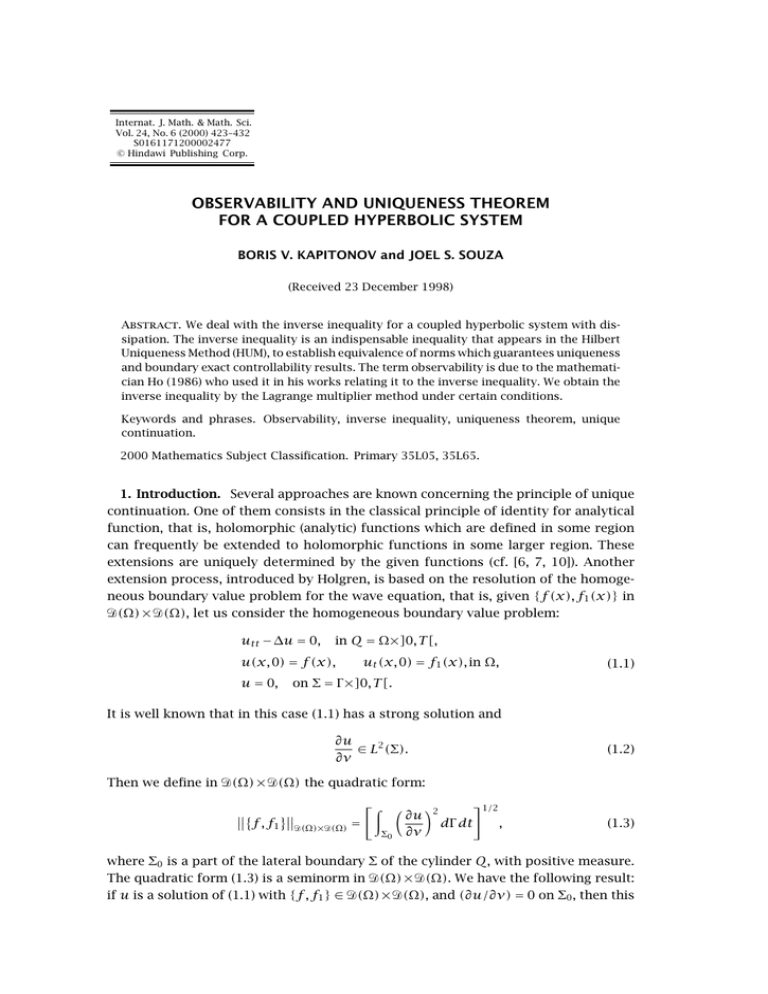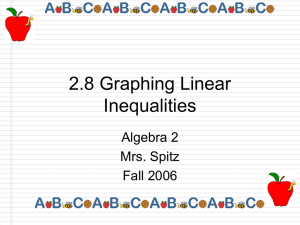Document 10463632
advertisement

Internat. J. Math. & Math. Sci.
Vol. 24, No. 6 (2000) 423–432
S0161171200002477
© Hindawi Publishing Corp.
OBSERVABILITY AND UNIQUENESS THEOREM
FOR A COUPLED HYPERBOLIC SYSTEM
BORIS V. KAPITONOV and JOEL S. SOUZA
(Received 23 December 1998)
Abstract. We deal with the inverse inequality for a coupled hyperbolic system with dissipation. The inverse inequality is an indispensable inequality that appears in the Hilbert
Uniqueness Method (HUM), to establish equivalence of norms which guarantees uniqueness
and boundary exact controllability results. The term observability is due to the mathematician Ho (1986) who used it in his works relating it to the inverse inequality. We obtain the
inverse inequality by the Lagrange multiplier method under certain conditions.
Keywords and phrases. Observability, inverse inequality, uniqueness theorem, unique
continuation.
2000 Mathematics Subject Classification. Primary 35L05, 35L65.
1. Introduction. Several approaches are known concerning the principle of unique
continuation. One of them consists in the classical principle of identity for analytical
function, that is, holomorphic (analytic) functions which are defined in some region
can frequently be extended to holomorphic functions in some larger region. These
extensions are uniquely determined by the given functions (cf. [6, 7, 10]). Another
extension process, introduced by Holgren, is based on the resolution of the homogeneous boundary value problem for the wave equation, that is, given {f (x), f1 (x)} in
Ᏸ(Ω) × Ᏸ(Ω), let us consider the homogeneous boundary value problem:
utt − ∆u = 0,
in Q = Ω×]0, T [,
u(x, 0) = f (x),
u = 0,
ut (x, 0) = f1 (x), in Ω,
(1.1)
on Σ = Γ ×]0, T [.
It is well known that in this case (1.1) has a strong solution and
∂u
∈ L2 (Σ).
∂ν
(1.2)
Then we define in Ᏸ(Ω) × Ᏸ(Ω) the quadratic form:
f , f1 Ᏸ(Ω)×Ᏸ(Ω) =
Σ0
∂u
∂ν
2
1/2
dΓ dt
,
(1.3)
where Σ0 is a part of the lateral boundary Σ of the cylinder Q, with positive measure.
The quadratic form (1.3) is a seminorm in Ᏸ(Ω) × Ᏸ(Ω). We have the following result:
if u is a solution of (1.1) with {f , f1 } ∈ Ᏸ(Ω)× Ᏸ(Ω), and (∂u/∂ν) = 0 on Σ0 , then this
424
B. V. KAPITONOV AND J. S. SOUZA
implies that u is zero in Q, i.e., the seminorm (1.3) is, indeed, a norm in Ᏸ(Ω)× Ᏸ(Ω).
This is true due to the Holgren’s theorem (cf. [3, 8]).
Our purpose in this paper is to establish a result of unique continuation in the
direction of the Holgren’s theorem based on a result of Ruiz [11]. We present this
approach as follows.
Let Ω be a bounded domain in Rn with boundary Γ = ∂Ω. In the cylinder Q = Ω×]0, T [
we consider the initial boundary value problem for the wave equation (1.1). We are
interested in the following result: there exists an open subset Ᏸ ⊂ Ω such that there
exists a time T > 0 and a constant C > 0, so that
T 2
2
ut dx dt + u2
ut + |∇u|2 dx ≤ C
L2 (Ω×(0,T )) ,
Ω
0 Ᏸ
∀ f , f1 ∈ H01 (Ω) × L2 (Ω).
(1.4)
Lions (cf. [9]) proved that this estimate holds if Ω is of class C 2 , and Ᏸ is a neighborhood of the part of the boundary Γ0 = Γ0 (x 0 ) = {x ∈ Γ ; (x − x 0 , ν(x)) > 0}, where
x 0 is some point of Rn , and ν(x) is the unit outer normal.
Bardos, Lebeau and Rauch [2] showed that, when Ω is of class C ∞ , inequality (1.4)
holds if Ᏸ satisfies some “geometric control property,” that is: there exists some T > 0
such that every ray of geometric optics intersects the set Ᏸ × (0, T ).
The estimate (1.4) implies the following unique continuation result: if v ∈ H 1 (Ω×
]0, T [) is solution of
vtt − ∆v + b(x)v = 0,
in Ω×]0, T [,
v = 0,
on Σ = Γ ×]0, T [,
v = 0,
in Ᏸ×]0, T [,
(1.5)
where b ∈ L∞ (Ᏸ×]0, T [), then
v ≡ 0,
in Ω×]0, T [,
(1.6)
see Zuazua [12].
2. Problem formulation. In the cylinder Ω×]0, T [ we consider the following initial
boundary value problem for the coupled hyperbolic system with dissipation
∂
∂u
∂v
∂2u
= 0,
−
A
+ B(x)
2
∂t
∂xi
∂xi
∂t
∂
∂v
∂u
∂2v
= 0,
−
A
− B(x)
∂t 2 ∂xi
∂xi
∂t
u(x, 0) = f (x),
v(x, 0) = g(x),
u (x, 0) = f (x), v (x, 0) = g (x),
t
u = 0,
1
v = 0,
t
(2.1a)
(2.1b)
in Ω,
(2.1c)
1
on Σ = Γ ×]0, T [,
(2.1d)
where u = (u1 , . . . , um ), (v 1 , . . . , v m ), A = A∗ and B(x) = B ∗ (x) are square matrices of
order m, and we are using the Einstein summation convention.
OBSERVABILITY AND UNIQUENESS THEOREM FOR A COUPLED . . .
425
We assume that
n
Aζi · ζi ≥ a0
i=1
n
2
ζi ,
a0 > 0, where ζi = ζi1 , . . . , ζim ∈ Rn
i=1
(2.2)
and B(x)η·η ≥ 0, x ∈ Ω, η ∈ Rm . We denote by Ᏼ the real Hilbert space of quadruples
{u, v, u1 , v1 } of m-compound vector-functions such that
m
u, v ∈ H 1 (Ω) ,
u|Γ = v|Γ = 0,
m
u1 , v1 ∈ L2 (Ω) .
(2.3)
The inner product in Ᏼ is defined by the formula
u, v, u1 , v1 , f , g, f1 , g1 Ᏼ =
Ω
A
∂v ∂g
∂u ∂f
·
+A
·
+ u1 · f1 + v1 · g1 dx.
∂xi ∂xi
∂xi ∂xi
(2.4)
We defined an unbounded operator Ꮽ in Ᏼ given by:
m
m ,
u, v, u1 , v1 ∈ Ᏼ; u, v ∈ H 2 (Ω) ∩ H01 (Ω) , u1 , v1 ∈ H01 (Ω)
∂
∂
∂u
∂v
Ꮽ u, v, u1 , v1 = u1 , v1 ,
A
− Bv1 ,
A
+ Bu1
∂xi
∂xi
∂xi
∂xi
for u, v, u1 , v1 ∈ Ᏸ(Ꮽ).
D(Ꮽ) =
(2.5)
In standard way, we can check that the domain Ᏸ(Ꮽ∗ ) of the adjoint operator is
given by:
m
m f , g, f1 , g1 ∈ Ᏼ; f , g ∈ H 2 (Ω) ∩ H01 (Ω) , f1 , g1 ∈ H01 (Ω)
,
∂
∂
∂f
∂g
(2.6)
Ꮽ∗ f , g, f1 , g1 = − f1 , g1 ,
A
− Bg1 ,
A
+ Bf1
∂xi
∂xi
∂xi
∂xi
for f , g, f1 , g1 ∈ D(Ꮽ∗ ).
D(Ꮽ∗ ) =
Thus, the operator Ꮽ is skew selfadjoint and from Stone’s theorem it follows that
it generates a 1-parameter group of unitary operators ᐁ(t) in Ᏼ. Moreover, ᐁ(t) is
strongly continuous in t and ᐁ(t){f , g, f1 , g1 } is strongly differentiable with respect
to t for
f , g, f1 , g1 ∈ D(Ꮽ)
and
d
ᐁ(t) f , g, f1 , g1 = Ꮽᐁ(t) f , g, f1 , g1 .
dt
(2.7)
Furthermore, ᐁ(t) takes D(Ꮽ) onto D(Ꮽ) are commutes with Ꮽ.
It follows that if {u, v, u1 , v1 } = ᐁ(t){f , g, f1 , g1 }, then u, v is strong solution to
problem (2.1), with ut = u1 , vt = v1 , and possesses the following regularity:
u, v, ut , vt ∈ C 0 [0, T ]; D(Ꮽ) ∩ C 1 [0, T ]; Ᏼ .
(2.8)
Now, we introduce the following notation:
φ(u) =
n
A
i=1
∂u ∂u
·
,
∂xi ∂xi
E(t) =
2 2
ut + vt + φ(u) + φ(v) dx.
Ω
(2.9)
426
B. V. KAPITONOV AND J. S. SOUZA
Since the operator ᐁ(t) is unitary, we have
2 2
E(t) ≡ ᐁ(t) f , g, f1 , g1 Ᏼ = f , g, f1 , g1 Ᏼ ≡ E(0),
∀t ∈ R.
(2.10)
We also observe that, for Ᏺ = {f , g, f1 , g1 } ∈ Ᏼ, ᐁ(t)Ᏺ is a weak solution in Ᏼ to the
abstract Cauchy problem
d
u, v, u1 , v1 = u1 , v1 , Au, Av
dt
(2.11)
T dΦ
ᐁ(t)Ᏺ,
+ ᐁ(t)Ᏺ, A∗ Φ Ᏼ dt = − Ᏺ, Φ(0) Ᏼ ,
dt Ᏼ
0
(2.12)
in the following sense:
for every Φ ∈ L2 (0, T ; D(A∗ )), Φt ∈ L2 (0, T ; Ᏼ), Φ(T ) = 0.
3. Observability and uniqueness theorem. In this section, we obtain the inverse
inequality by using the Lagrange multiplier method with certain conditions over an
arbitrary neighborhood Ᏸ ⊂ Ω.
It is easy to verify that the unperturbed wave equation of (2.1a) and (2.1b) is variational and that the expression
n
2
∂u
1 ∂u ∂u 1 ᏸ ut ,
A
·
− ut =
∂xi
2 i=1 ∂xi ∂xi 2
(3.1)
is its Lagrangian.
The invariance of the elementary action ᏸdx1 · · · dxn dt under the 1-parameter
group of dilations in all variables with infinitesimal operator
t
∂
n−1 q ∂
∂ + xi − xi0
u
−
∂t
∂xi
2
∂uq
(3.2)
leads to a conservation law (cf. [1, E. Noether’s theorem, page 88]). Now let {f , g, f1 , g1 }
∈ D(Ꮽ) and let u(x, t), v(x, y) be a solution of problem (2.1).
After integration by parts, over the cylinder Ω×]0, T [, that conservation law we then
obtain the identity:
T E(T ) +
t=T
2(∇ϕ, ∇)u · ut + 2(∇ϕ, ∇)v · vt + C(x)u · ut + C(x)v · vt dx Ω
t=0
T ∂v φ(u) + φ(v) dΓ dt
=
0 Γ ∂ν
T +
2(∇ϕ, ∇)v · But − 2(∇ϕ, ∇)u · Bvt + Cv · But
0
Ω
(3.3)
1
− CBvt · u + ∆C(Au · u + Av · v) + (u) + (v) dx dt,
2
where the pair (u, v) is a solution of (2.1); ϕ(x), C(x) are smooth functions in Ω, and
2 (u) = φ(u) ∆ϕ + 1 − C(x) + ut 1 + C(x) − ∆φ − 2ϕxi xj Auxj · uxi .
(3.4)
427
OBSERVABILITY AND UNIQUENESS THEOREM FOR A COUPLED . . .
We observe that identities of the kind in (3.3) are common in [4, 5]. We have that
2(∇ϕ, ∇)v · But ≤ εB(∇ϕ, ∇)v · (∇ϕ, ∇)v + 1 But · ut ,
ε
1
2(∇ϕ, ∇)u · Bvt ≤ εB(∇ϕ, ∇)u · (∇ϕ, ∇)u + Bvt · vt ,
ε
∂
Cv · But − CBvt · u = 2Cv · But − (Cv · Bu)
∂t
∂
1
≤ − (Cv · Bu) + ε|C|Bv · v + |C|But · ut .
∂t
ε
(3.5)
From these inequalities we obtain
T 0
2(∇ϕ, ∇)v · But − 2(∇ϕ, ∇)u · Bvt + Cv · But − CBvt · u dx dt
Ω
t=0
1 T
(1 + |C|)But · ut + Bvt · vt dx dt
Cv · Bu dx +
ε 0 Ω
Ω
t=T
T
φ(u) + φ(v) dx dt.
+ εC0 B, C(x), ϕ, a0 , Ω
≤
0
(3.6)
Ω
From the identity
T Ω
0
Bvt · vt dx dt =
T 0
Ω
But · ut dx dt −
t=T
,
ut · vt + Auxj · vxj dx Ω
t=0
(3.7)
it follows that
T 0
Ω
Bvt · vt dx dt ≤ E(0) +
T 0
Ω
But · ut dx dt.
(3.8)
So, using this inequality, from (3.6) we obtain
T 0
Ω
2(∇ϕ, ∇)v · But − 2(∇ϕ, ∇)u · Bvt + Cv · But − CBvt · u dx dt
T 1
(2 + |C|)But · ut dx dt + C0 +
E(0) + εC0 T E(0),
ε
0 Ω
t=T 2(∇ϕ, ∇)u · ut + 2(∇ϕ, ∇)v · vt + C(x)u · ut + C(x)v · vt dx Ω
t=0 ≤ C1 |∇ϕ|, C(x), a0 , Ω E(0).
≤
1
ε
We then arrive at the following inequality:
1
T E(0) + εC0 T E(0) − C1 E(0) − c0 +
E(0)
ε
T 1 T
∂ϕ ≤
φ(u) + φ(v) dΓ +
(2 + |C|)But · vt dx dt
∂ν
ε
0 Γ
0 Ω
T 1
+
∆C(Au · u + Av · v) + (u) + (v) dx dt.
0 Ω 2
(3.9)
(3.10)
Now for an arbitrary point x 0 ∈ Rn we find:
Γ0 = x ∈ Γ ; x − x 0 , ν(x) ≥ 0 ,
Γ1 = Γ \Γ0 .
(3.11)
428
B. V. KAPITONOV AND J. S. SOUZA
Let Ᏸ ⊂ Ω be an arbitrary neighborhood of Γ0 . There exists a function ϕ(x) such that
(i) (∂ϕ/∂ν) ≤ 0 on Γ ,
(ii) ϕ0 (x) ≥ µ > 0, in Ω\Ᏸ, where ϕ0 (x) = inf ∂ 2 ϕ/∂xi ∂xj ηi ηj .
Setting C(x) = ∆ϕ − 2ϕ0 (x) + µ, we have
2 (u) = φ(u) ∆φ + 1 − C(x) + ut 1 + C(x) − ∆ϕ − 2ϕxi xj Auxi uxi
2 ≤ φ(u) ∆ϕ + 1 − C(x) − 2ϕ0 φ(u) + ut 1 + C(x) − ∆ϕ
2
= (1 − µ)φ(u) + 1 − 2ϕ0 (x) + µ ut ,
T (u) + (v) dx dt
0 Ω
T 2 2
≤
dx dt
(1 − µ) φ(u) + φ(v) + 1 + µ − 2ϕ0 (x) ut + vt 0 Ω
T 2 2
ut + vt + φ(u) + φ(v) dx dt
≤ (1 − µ)
0
+
T 0
2 2 (1 − µ) φ(u) + φ(v) + 1 + µ − 2ϕ0 ut + vt dx dt
Ᏸ
= (1 − µ)
Ω\Ᏸ
T 0
Ω
E(t) dt +
T 0
Ᏸ
2 2 2 µ − ϕ0 ut + vt dx dt
≤ (1 − µ)T E(0) + 2 µ + sup ϕ0 T 2 2 ut + vt dx dt.
0
Ᏸ
(3.12)
We assume that
B(x)u · u ≥ b0 |u|2 ,
in Ᏸ,
(3.13)
then
T 2
vt dx dt ≤ 1
b0
Ᏸ
0
≤
≤
1
b0
T 0
Ᏸ
0
Ω
T B(x)vt · vt dx dt
B(x)vt · vt dx dt
1
1
E0 +
b0
b0
T 0
Ω
(3.14)
B(x)ut · ut dx dt,
and similarly,
T 0
2
ut dx dt ≤ 1
bo
Ᏸ
T 0
Ω
B(x)ut · ut dx dt.
(3.15)
From these inequalities we obtain
T 0
Ω
(u) + (v) dx dt
2 µ + sup ϕ0 E(0)
b0
T
4 But · ut dx dt.
µ + sup ϕ0
+
b0
0 Ω
≤ (1 − µ)T E(0) +
(3.16)
OBSERVABILITY AND UNIQUENESS THEOREM FOR A COUPLED . . .
429
Inequalities (3.10) and (3.16) lead to
2 1
µ + sup ϕ0 E(0)
T µ−εC0 E(0) − C0 + C1 + +
ε b0
T
4 1
(2 + sup |C|) +
But · ut dx dt
µ + sup ϕ0 ≤
ε
b0
0 Ω
T 1
∆C(Au · u + Av · v) dx dt.
+
0 Ω 2
(3.17)
In the general case, we can choose function ϕ(x) in the following way:
ϕ(x) =
1
x − x 0 2 ,
2
x ∈ Ω\Ᏸ,
(3.18)
and extend it in Ᏸ satisfying the property (i). Then,
∆C = ∆ ∆ϕ − 2ϕ0 (x) + µ ≡ 0,
in Ω\Ᏸ.
(3.19)
Thus, from (3.17), we arrive at the inequality:
2 1
T µ−εC0 E(0) + C0 + C1 + +
µ + sup ϕ0 E(0)
ε b0
T
4 1
(2 + sup |C|) +
But · ut dx dt
µ + sup ϕ0 ≤
ε
b0
0 Ω
T u2L2 (Ᏸ) + v2L2 (Ᏸ) dt.
+ C2 (ϕ, A)
(3.20)
0
Now we can assume that there exists a function ϕ(x) which satisfy (i), (ii), and
(iii) ∆2 ϕ − 2∆ϕ0 (x) ≤ 0, in Ω.
(We can construct some examples of these functions under certain assumptions on Ω
and Ᏸ.) In this case, from (3.17), it follows
2 1
T µ−εC0 E(0) − C0 + C1 + +
µ + sup ϕ0 E(0)
ε b0
T 4 1
2 + sup |C| +
But · ut dx dt.
µ + sup ϕ0 ≤
ε
b0
0 Ω
(3.21)
We choose ε such that µ > εC0 (we can set ε = (µ/2C0 )), and
T>
2C0 2C1 4C0
4
1
+
+ 2 +
1 + sup ϕ0 ≡ T0 .
µ
µ
µ
b0
µ
(3.22)
Then (3.20) and (3.21) can be rewritten in the following way:
µ
T − T0 E(0) ≤ C
2
T 0
Ω
But · ut dx dt + C2 (ϕ, A)
µ
T − T0 E(0) ≤ C
2
where C = C(ϕ,
b0 , a0 , Ω).
T 0
Ω
T 0
u2L2 (Ᏸ) v2L2 (Ᏸ) dt,
But · ut dx dt,
(3.23)
(3.24)
430
B. V. KAPITONOV AND J. S. SOUZA
4. Conclusion. We arrive at the following assertion: in the cylinder Ω×]0, T [, we
consider the initial boundary value problem for the following coupled hyperbolic system with dissipation:
∂
∂v
∂u
∂2u
= 0,
−
A
+ ᐄᏰ (x)B(x)
∂t 2 ∂xi
∂xi
∂t
∂2v
∂
∂u
∂v
= 0,
−
A
− ᐄᏰ (x)B(x)
2
∂t
∂xi
∂xi
∂t
(4.1)
u(x, 0) = f (x),
v(x, 0) = g(x),
in Ω,
u (x, 0) = f (x), v (x, 0) = g (x),
t
1
u = v = 0,
t
1
on Σ = Γ ×]0, T [.
Here A = A∗ , B(x) = B ∗ (x), B(x)η · η ≥ b0 |η|2 , b0 > 0; Aζi · ζi ≥ a0 |ζi |2 , a0 > 0, B ∈
L∞ (Ᏸ), and
1, x ∈ Ᏸ,
(4.2)
ᐄᏰ (x) =
0, x ∈ Ᏸ,
where Ᏸ is an arbitrary neighborhood of the boundary (or a part of the boundary). We
have that:
(1) If Ᏸ is an arbitrary neighborhood of Γ0 = {x ∈ Γ ; (x − x 0 , ν(x)) ≥ 0}, then there
exists T0 > 0 such that, for T > T0 , the following inequality holds:
2 2
ut + vt + φ(u) + φ(v) dx
T − T0
Ω
(4.3)
T T 2
2
2
ut dx dt + C2
uL2 (Ᏸ) + vL2 (Ᏸ) dt.
≤ C1
0
Ᏸ
0
(2) If Ᏸ and Ω are such that there exists a function ϕ(t) with properties (i), (ii), and
(iii), then, for T > T0 , we have
T 2
2 2
ut + vt + φ(u) + φ(v) dx ≤ C
ut dx dt.
(4.4)
T − T0
Ω
0
Ᏸ
Remark 4.1. Let us consider the coupled system:
∂
∂v
∂u
∂2u
= 0,
−
A
+ G(x)u + ᐄᏰ(x)B(x)
∂t 2 ∂xi
∂xi
∂t
∂2v
∂
∂u
∂v
= 0,
−
A
+ G(x)v − ᐄᏰ(x)B(x)
2
∂t
∂xi
∂xi
∂t
(4.5)
where A, B, and Ᏸ are defined above, G = G∗ , with G(x)η · η ≥ 0, x ∈ Ω; and support
(G) ⊆ Ᏸ̄, G ∈ W 1,∞ (Ᏸ).
These new terms considered add to the right-hand side of the main identity (3.3)
(and the rest of the formulas) the following expression:
T ϕxi Gxi u · u + (∆ϕ + 1 − C)Gu · u + ϕxi Gxi v · v + (∆ϕ + 1 − C)Gv · v dx dt.
0
Ω
(4.6)
OBSERVABILITY AND UNIQUENESS THEOREM FOR A COUPLED . . .
431
(In this case, E(t)
= Ω [|u|2 + |v|2 + φ(u) + φ(v) + Gu · u + Gv · v] dx.) After the
substitution C = ∆ϕ − 2ϕ0 + µ, this expression takes the form
(1 − µ)
T 0
Ω
+
(Gu · u + Gv · v) dx dt
(4.7)
ϕxi Gxi u · u + 2ϕ0 Gu · u + ϕxi Gxi v · v + 2ϕ0 Gv · v dx dt.
T 0
Ω
Thus, we obtain under the same assumption:
(1) In the first case,
2 2
ut + vt + φ(u) + φ(v) + Gu · u + Gv · v dx
(T − T0 )
Ω
≤ C1
T 0
Ᏸ
2
ut dx dt + C2
T 0
u2L2 (Ᏸ) + v2L2 (Ᏸ) dt.
(4.8)
(2) In the second case:
≤ C1
T − T0 E(t)
T 0
Ᏸ
2
ut dx dt + C3
T 0
u2L2 (Ᏸ) + v2L2 (Ᏸ) dt,
(4.9)
i.e., in this situation only the first case makes sense.
Thus, we have the following results of unique continuation, i.e., if Ᏸ ⊂ Ω is an arbitrary neighborhood of Γ0 satisfying (i) and (ii), with support (G) ⊆ Ᏸ̄, and the pair (u, v)
is a strong solution of the initial boundary value problem for the coupled system (4.5)
with homogeneous Dirichlet condition and
u ≡ v ≡ 0,
in Ᏸ×]0, T [,
(4.10)
u ≡ v ≡ 0,
in Ω×]0, T [.
(4.11)
then
Acknowledgement. Kapitonov was supported by Russian Fund of Fundamental Research, project 94-01-0078; and Souza was supported by CNPq grant Proc.
20.0692/97.6, Brazil.
References
[1]
[2]
[3]
[4]
V. I. Arnold, Mathematical Methods of Classical Mechanics, Graduate Texts in Mathematics, vol. 60, Springer-Verlag, New York, Berlin, 1989, Translated from the Russian
by K. Vogtman and A. Weinstein. MR 90c:58046.
C. Bardos, G. Lebeau, and J. Rauch, Un exemple d’utilisation des notions de propagation pour le contrôle et la stabilisation de problèmes hyperboliques, Rend. Sem.
Mat. Univ. Politec. Torino (1988), Special Issue, 11–31 (1989), Appendix II of [8].
MR 90h:35030. Zbl 673.93037.
L. Hörmander, Linear Partial Differential Operators, Springer-Verlag, Berlin, 1976.
MR 53#8622. Zbl 321.35001.
B. V. Kapitonov, Uniqueness theorems and exact boundary control for evolution systems,
Sibirsk. Mat. Zh. 34 (1993), no. 5, 67–84, ii, vii, translated in Siberian Math. J. 34
(1993), no. 5, 852–868. MR 95b:93020. Zbl 816.93043.
432
[5]
[6]
[7]
[8]
[9]
[10]
[11]
[12]
B. V. KAPITONOV AND J. S. SOUZA
, Stabilization and exact boundary controllability for Maxwell’s equations, SIAM J.
Control Optim. 32 (1994), no. 2, 408–420. MR 94k:93010. Zbl 827.35012.
E. L. Lima, Curso de Análise. Vol. 1, Instituto de Matemática Pura e Aplicada, Rio de Janeiro,
1976. MR 83h:26002a. Zbl 511.26002.
, Curso de Análise. Vol. 2, Instituto de Matemática Pura e Aplicada, Rio de Janeiro,
1981. MR 83h:26002b. Zbl 511.26003.
J.-L. Lions, Contrôlabilité Exacte, Perturbations et Stabilisation de Systèmes Distribués.
Tome 1, Masson, Paris, 1988. MR 90a:49040. Zbl 653.93002.
, Exact controllability, stabilization and perturbations for distributed systems, SIAM
Rev. 30 (1988), no. 1, 1–68. MR 89e:93019. Zbl 644.49028.
W. Rudin, Real and Complex Analysis, McGraw-Hill Book Co., New York, 1987.
MR 88k:00002. Zbl 925.00005.
A. Ruiz, Unique continuation for weak solutions of the wave equation plus a potential, J.
Math. Pures Appl. (9) 71 (1992), no. 5, 455–467. MR 94c:35043. Zbl 832.35084.
E. Zuazua, Exponential decay for the semilinear wave equation with locally distributed damping, Comm. Partial Differential Equations 15 (1990), no. 2, 205–235.
MR 91b:35076. Zbl 716.35010.
Boris V. Kapitonov: Institute of Mathematics, Russian Academy of Sciences and Universidade Federal de Santa Catarina, Russia
Joel S. Souza: Departamento de Matemática da Universidade Federal de Santa Catarina C.P. 476, CEP 88040-900, Florianópolis, SC, Brazil
E-mail address: jsouza@mtm.ufsc.br









